stop start YAMAHA XVS950 2015 Owners Manual
[x] Cancel search | Manufacturer: YAMAHA, Model Year: 2015, Model line: XVS950, Model: YAMAHA XVS950 2015Pages: 88, PDF Size: 2.28 MB
Page 20 of 88
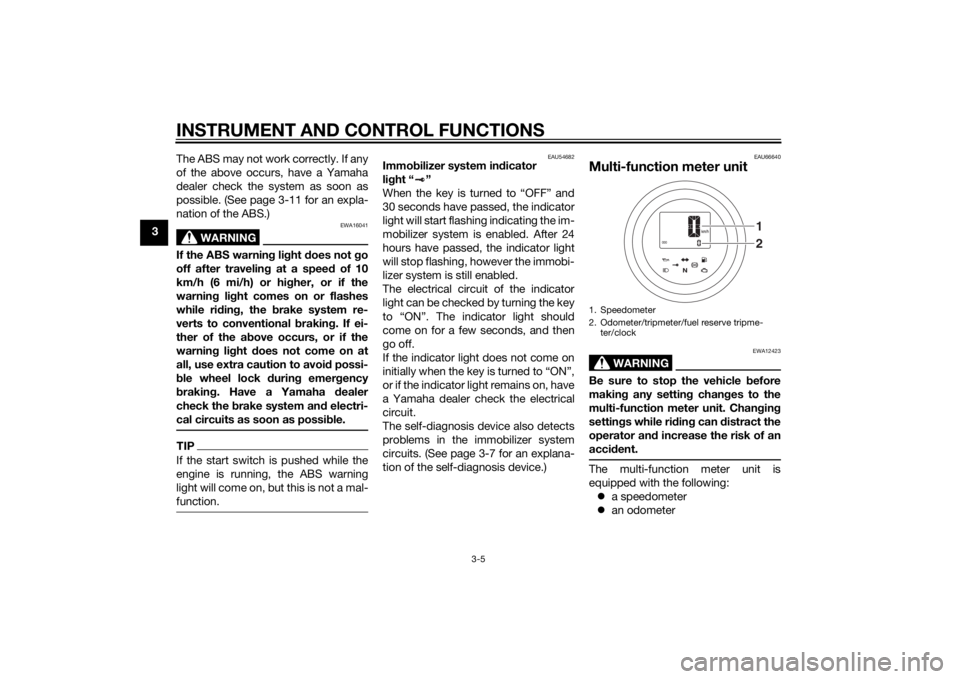
INSTRUMENT AND CONTROL FUNCTIONS
3-5
3The ABS may not work correctly. If any
of the above occurs, have a Yamaha
dealer check the system as soon as
possible. (See page 3-11 for an expla-
nation of the ABS.)
WARNING
EWA16041
If the ABS warnin
g li ght does not go
off after travelin g at a speed of 10
km/h (6 mi/h) or hi gher, or if the
warnin g li ght comes on or flashes
while ri din g, the b rake system re-
verts to conventional brakin g. If ei-
ther of the ab ove occurs, or if the
warnin g li ght does not come on at
all, use extra caution to avoi d possi-
b le wheel lock during emer gency
b rakin g. Have a Yamaha d ealer
check the brake system an d electri-
cal circuits as soon as possi ble.TIPIf the start switch is pushed while the
engine is running, the ABS warning
light will come on, but this is not a mal-
function.
EAU54682
Immo bilizer system in dicator
li g ht “ ”
When the key is turned to “OFF” and
30 seconds have passed, the indicator
light will start flashing indicating the im-
mobilizer system is enabled. After 24
hours have passed, the indicator light
will stop flashing, however the immobi-
lizer system is still enabled.
The electrical circuit of the indicator
light can be checked by turning the key
to “ON”. The indicator light should
come on for a few seconds, and then
go off.
If the indicator light does not come on
initially when the key is turned to “ON”,
or if the indicator light remains on, have
a Yamaha dealer check the electrical
circuit.
The self-diagnosis device also detects
problems in the immobilizer system
circuits. (See page 3-7 for an explana-
tion of the self-diagnosis device.)
EAU66640
Multi-function meter unit
WARNING
EWA12423
Be sure to stop the vehicle before
makin g any settin g chan ges to the
multi-function meter unit. Chan gin g
settin gs while ri din g can distract the
operator an d increase the risk of an
acci dent.The multi-function meter unit is
equipped with the following:
a speedometer
an odometer1. Speedometer
2. Odometer/tripmeter/fuel reserve tripme-
ter/clock
21
UB33E0E0.book Page 5 Monday, December 1, 2014 4:49 PM
Page 23 of 88

INSTRUMENT AND CONTROL FUNCTIONS
3-8
3
key and both standard keys to a
Yamaha dealer and have the stan- dard keys re-registered.
NOTICE
ECA11591
If the display in dicates an error
co de, the vehicle shoul d b e checked
as soon as possi ble in or der to avoi d
en gine damag e.
EAU1234H
Handle bar switchesLeft Ri
ght
EAU12351
Pass switch “ ”
Press this switch to flash the headlight.
EAU12401
Dimmer switch “ / ”
Set this switch to “ ” for the high
beam and to “ ” for the low beam.
EAU12461
Turn si gnal switch “ / ”
To signal a right-hand turn, push this
switch to “ ”. To signal a left-hand
turn, push this switch to “ ”. When
released, the switch returns to the cen-
1. Pass switch “ ”
2. Dimmer switch “ / ”
3. Turn signal switch “ / ”
4. Horn switch “ ”
1234
1. Start/Engine stop switch “ / / ”
2. “SELECT” switch
3. Hazard switch “ ”
213
UB33E0E0.book Page 8 Monday, December 1, 2014 4:49 PM
Page 24 of 88
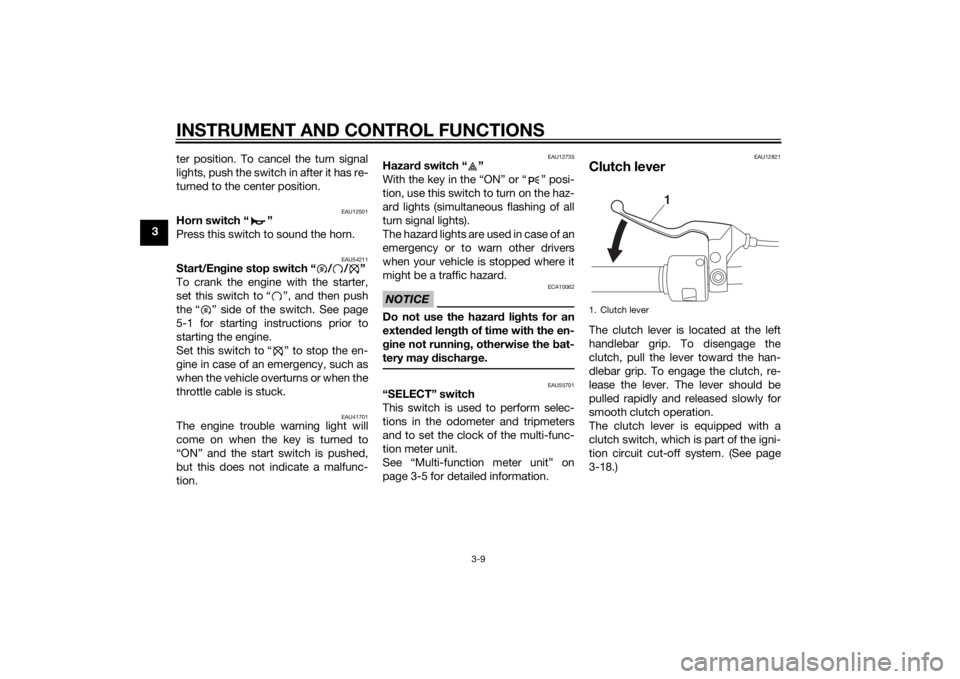
INSTRUMENT AND CONTROL FUNCTIONS
3-9
3ter position. To cancel the turn signal
lights, push the switch in after it has re-
turned to the center position.
EAU12501
Horn switch “ ”
Press this switch to sound the horn.
EAU54211
Start/En
gine stop switch “ / / ”
To crank the engine with the starter,
set this switch to “ ”, and then push
the “ ” side of the switch. See page
5-1 for starting instructions prior to
starting the engine.
Set this switch to “ ” to stop the en-
gine in case of an emergency, such as
when the vehicle overturns or when the
throttle cable is stuck.
EAU41701
The engine trouble warning light will
come on when the key is turned to
“ON” and the start switch is pushed,
but this does not indicate a malfunc-
tion.
EAU12735
Hazar d switch “ ”
With the key in the “ON” or “ ” posi-
tion, use this switch to turn on the haz-
ard lights (simultaneous flashing of all
turn signal lights).
The hazard lights are used in case of an
emergency or to warn other drivers
when your vehicle is stopped where it
might be a traffic hazard.NOTICE
ECA10062
Do not use the hazard lights for an
exten ded len gth of time with the en-
g ine not runnin g, otherwise the bat-
tery may dischar ge.
EAU55701
“SELECT” switch
This switch is used to perform selec-
tions in the odometer and tripmeters
and to set the clock of the multi-func-
tion meter unit.
See “Multi-function meter unit” on
page 3-5 for detailed information.
EAU12821
Clutch leverThe clutch lever is located at the left
handlebar grip. To disengage the
clutch, pull the lever toward the han-
dlebar grip. To engage the clutch, re-
lease the lever. The lever should be
pulled rapidly and released slowly for
smooth clutch operation.
The clutch lever is equipped with a
clutch switch, which is part of the igni-
tion circuit cut-off system. (See page
3-18.)1. Clutch lever
1
UB33E0E0.book Page 9 Monday, December 1, 2014 4:49 PM
Page 32 of 88
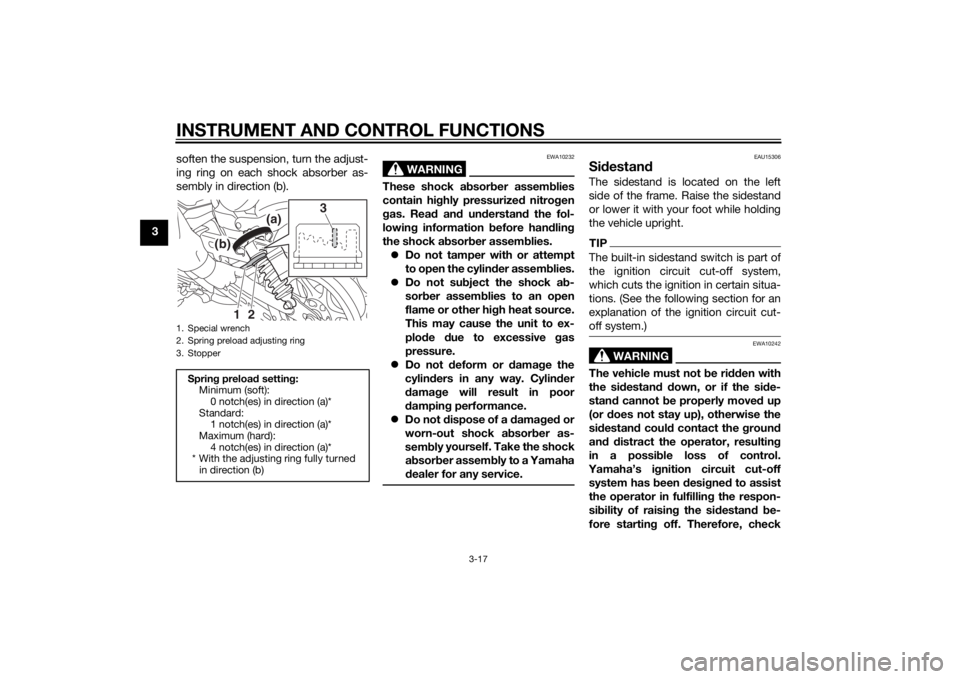
INSTRUMENT AND CONTROL FUNCTIONS
3-17
3soften the suspension, turn the adjust-
ing ring on each shock absorber as-
sembly in direction (b).
WARNING
EWA10232
These shock ab
sorber assem blies
contain hi ghly pressurize d nitro gen
g as. Rea d an d un derstan d the fol-
lowin g information b efore handlin g
the shock a bsor ber assem blies.
Do not tamper with or attempt
to open the cylin der assem blies.
Do not su bject the shock a b-
sor ber assem blies to an open
flame or other hi gh heat source.
This may cause the unit to ex-
plo de due to excessive gas
pressure.
Do not deform or d amage the
cylin ders in any way. Cylin der
d amag e will result in poor
d ampin g performance.
Do not dispose of a damag ed or
worn-out shock a bsor ber as-
sem bl
y yourself. Take the shock
a b sor ber assem bly to a Yamaha
d ealer for any service.
EAU15306
Si destan dThe sidestand is located on the left
side of the frame. Raise the sidestand
or lower it with your foot while holding
the vehicle upright.TIPThe built-in sidestand switch is part of
the ignition circuit cut-off system,
which cuts the ignition in certain situa-
tions. (See the following section for an
explanation of the ignition circuit cut-
off system.)
WARNING
EWA10242
The vehicle must not be ri dden with
the si destan d d own, or if the si de-
stan d cannot b e properly moved up
(or does not stay up), otherwise the
si destan d coul d contact the groun d
an d d istract the operator, resultin g
in a possi ble loss of control.
Yamaha’s i gnition circuit cut-off
system has been desi gne d to assist
the operator in fulfillin g the respon-
si bility of raisin g the si destan d b e-
fore startin g off. Therefore, check
1. Special wrench
2. Spring preload adjusting ring
3. StopperSprin g preloa d setting :
Minimum (soft):
0 notch(es) in direction (a)*
Standard: 1 notch(es) in direction (a)*
Maximum (hard): 4 notch(es) in direction (a)*
* With the adjusting ring fully turned
in direction (b)
2
(a)
(b)
1
3
UB33E0E0.book Page 17 Monday, December 1, 2014 4:49 PM
Page 34 of 88
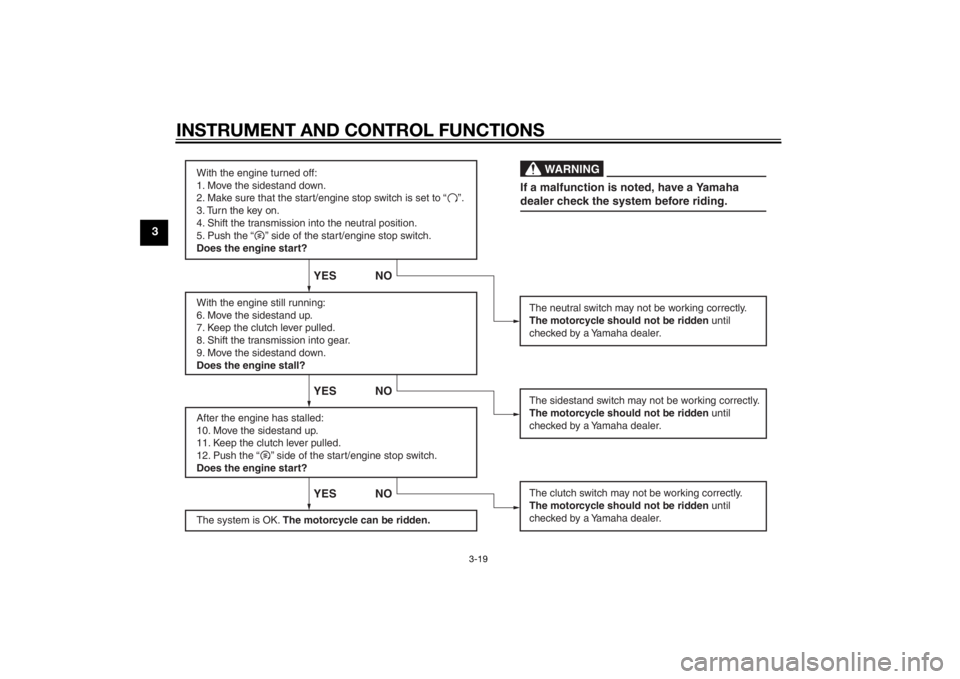
INSTRUMENT AND CONTROL FUNCTIONS
3-19
3
With the engine turned off:
1. Move the sidestand down.
2. Make sure that the start/engine stop switch is set to “ ”.
3. Turn the key on.
4. Shift the transmission into the neutral position.
5. Push the “ ” side of the start/engine stop switch.
Does the engine start?
With the engine still running:
6. Move the sidestand up.
7. Keep the clutch lever pulled.
8. Shift the transmission into gear.
9. Move the sidestand down.
Does the engine stall?
After the engine has stalled:
10. Move the sidestand up.
11. Keep the clutch lever pulled.
12. Push the “ ” side of the start/engine stop switch.
Does the engine start?
The system is OK. The motorcycle can be ridden.
YES NO YES NO YES NO
The neutral switch may not be working correctly.
The motorcycle should not be ridden until
checked by a Yamaha dealer.
The clutch switch may not be working correctly.
The motorcycle should not be ridden until
checked by a Yamaha dealer.The sidestand switch may not be working correctly.
The motorcycle should not be ridden until
checked by a Yamaha dealer.If a malfunction is noted, have a Yamaha
dealer check the system before riding.
WA R N I N G
UB33E0E0.book Page 19 Monday, December 1, 2014 4:49 PM
Page 38 of 88
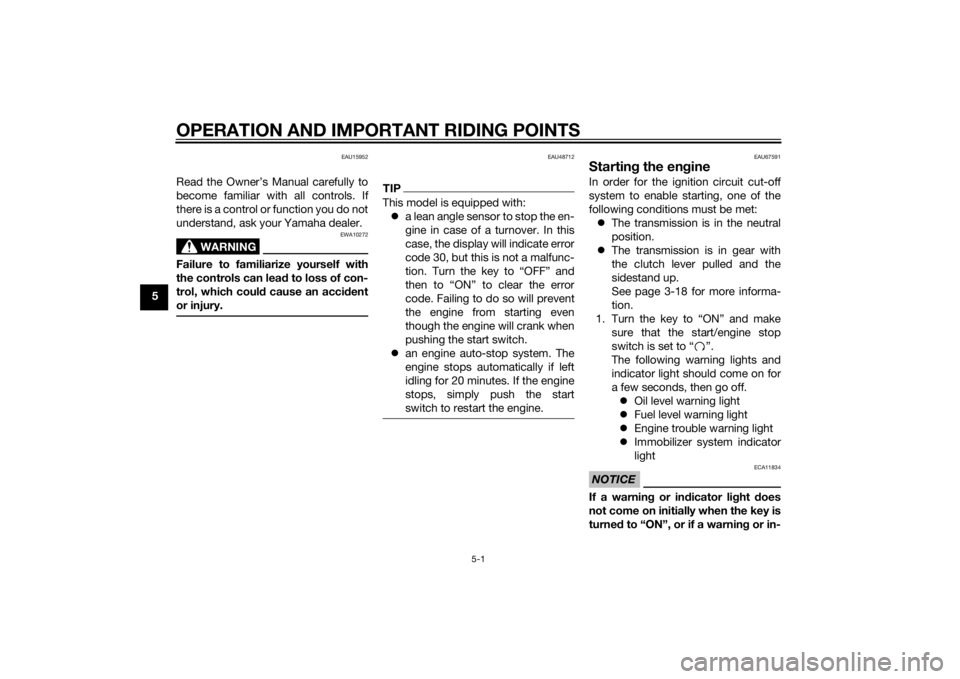
OPERATION AND IMPORTANT RIDING POINTS
5-1
5
EAU15952
Read the Owner’s Manual carefully to
become familiar with all controls. If
there is a control or function you do not
understand, ask your Yamaha dealer.
WARNING
EWA10272
Failure to familiarize yourself with
the controls can lead to loss of con-
trol, which coul d cause an acci dent
or injury.
EAU48712
TIPThis model is equipped with: a lean angle sensor to stop the en-
gine in case of a turnover. In this
case, the display will indicate error
code 30, but this is not a malfunc-
tion. Turn the key to “OFF” and
then to “ON” to clear the error
code. Failing to do so will prevent
the engine from starting even
though the engine will crank when
pushing the start switch.
an engine auto-stop system. The
engine stops automatically if left
idling for 20 minutes. If the engine
stops, simply push the start
switch to restart the engine.
EAU67591
Startin g the en gineIn order for the ignition circuit cut-off
system to enable starting, one of the
following conditions must be met:
The transmission is in the neutral
position.
The transmission is in gear with
the clutch lever pulled and the
sidestand up.
See page 3-18 for more informa-
tion.
1. Turn the key to “ON” and make sure that the start/engine stop
switch is set to “ ”.
The following warning lights and
indicator light should come on for
a few seconds, then go off. Oil level warning light
Fuel level warning light
Engine trouble warning light
Immobilizer system indicator
lightNOTICE
ECA11834
If a warnin g or in dicator li ght does
not come on initially when the key is
turne d to “ON”, or if a warning or in-
UB33E0E0.book Page 1 Monday, December 1, 2014 4:49 PM
Page 39 of 88
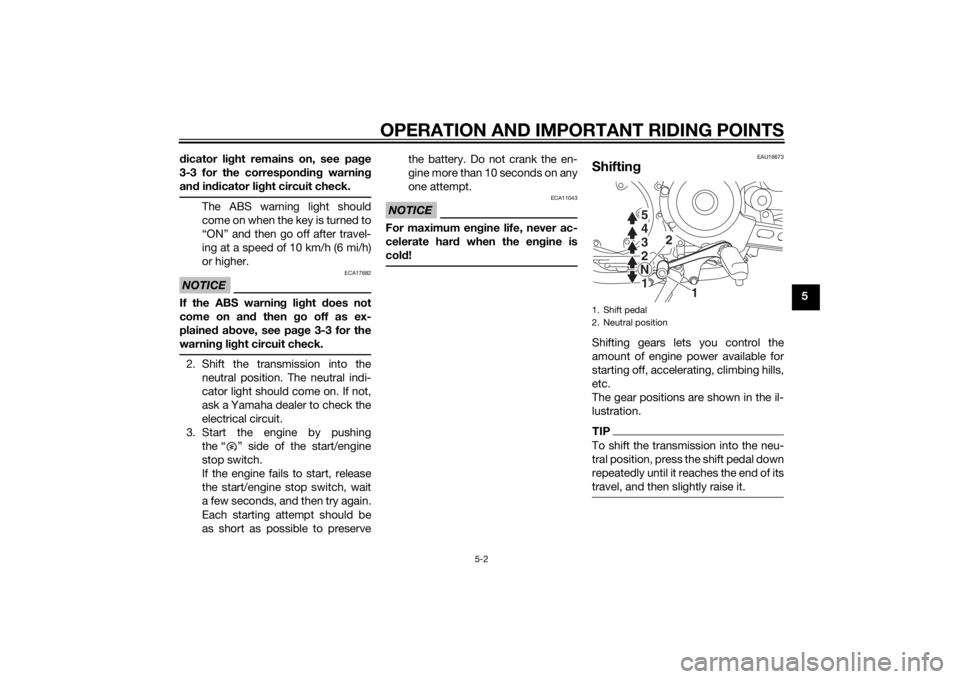
OPERATION AND IMPORTANT RIDING POINTS
5-2
5
d
icator li ght remains on, see pa ge
3-3 for the correspon din g warnin g
an d in dicator li ght circuit check.
The ABS warning light should
come on when the key is turned to
“ON” and then go off after travel-
ing at a speed of 10 km/h (6 mi/h)
or higher.
NOTICE
ECA17682
If the ABS warnin g li ght does not
come on an d then go off as ex-
plaine d a bove, see pa ge 3-3 for the
warnin g li ght circuit check.2. Shift the transmission into the
neutral position. The neutral indi-
cator light should come on. If not,
ask a Yamaha dealer to check the
electrical circuit.
3. Start the engine by pushing the “ ” side of the start/engine
stop switch.
If the engine fails to start, release
the start/engine stop switch, wait
a few seconds, and then try again.
Each starting attempt should be
as short as possible to preserve the battery. Do not crank the en-
gine more than 10 seconds on any
one attempt.
NOTICE
ECA11043
For maximum en
gine life, never ac-
celerate har d when the en gine is
col d!
EAU16673
Shiftin gShifting gears lets you control the
amount of engine power available for
starting off, accelerating, climbing hills,
etc.
The gear positions are shown in the il-
lustration.TIPTo shift the transmission into the neu-
tral position, press the shift pedal down
repeatedly until it reaches the end of its
travel, and then slightly raise it.1. Shift pedal
2. Neutral position
1
2
5
4
3
2
N 1 5
4
3
2
N 1
UB33E0E0.book Page 2 Monday, December 1, 2014 4:49 PM
Page 40 of 88
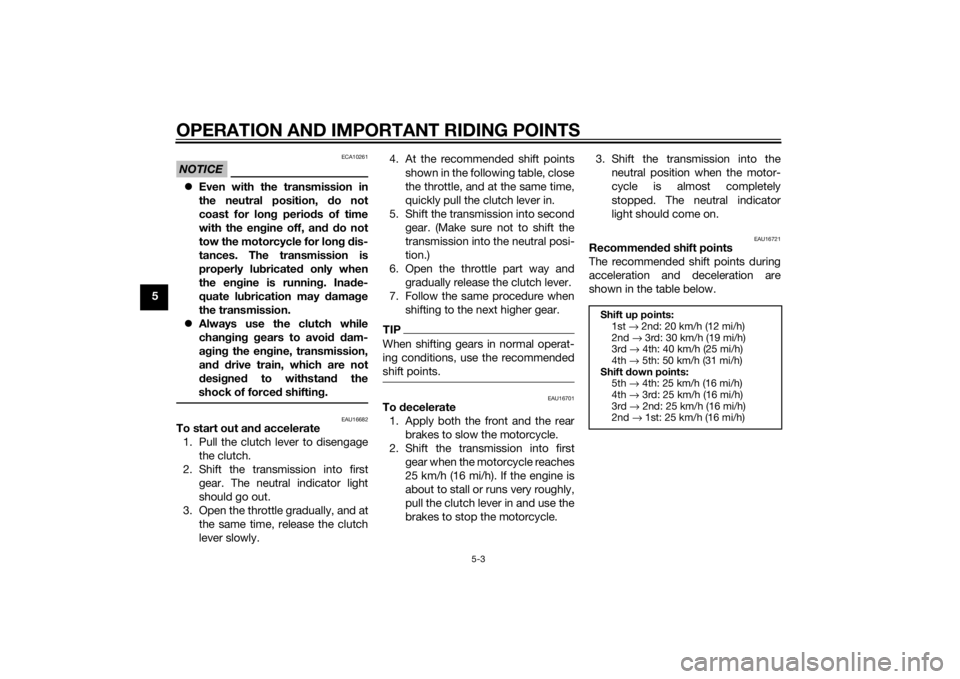
OPERATION AND IMPORTANT RIDING POINTS
5-3
5
NOTICE
ECA10261
Even with the transmission in
the neutral position, do not
coast for lon g period s of time
with the en gine off, an d d o not
tow the motorcycle for lon g d is-
tances. The transmission is
properly lu bricated only when
the en gine is runnin g. Ina de-
quate lu brication may damag e
the transmission.
Always use the clutch while
chan gin g g ears to avoi d d am-
a g in g the en gine, transmission,
an d d rive train, which are not
d esi gne d to withstan d the
shock of force d shifting .
EAU16682
To start out an d accelerate
1. Pull the clutch lever to disengage the clutch.
2. Shift the transmission into first gear. The neutral indicator light
should go out.
3. Open the throttle gradually, and at the same time, release the clutch
lever slowly. 4. At the recommended shift points
shown in the following table, close
the throttle, and at the same time,
quickly pull the clutch lever in.
5. Shift the transmission into second gear. (Make sure not to shift the
transmission into the neutral posi-
tion.)
6. Open the throttle part way and gradually release the clutch lever.
7. Follow the same procedure when shifting to the next higher gear.
TIPWhen shifting gears in normal operat-
ing conditions, use the recommended
shift points.
EAU16701
To decelerate
1. Apply both the front and the rear brakes to slow the motorcycle.
2. Shift the transmission into first gear when the motorcycle reaches
25 km/h (16 mi/h). If the engine is
about to stall or runs very roughly,
pull the clutch lever in and use the
brakes to stop the motorcycle. 3. Shift the transmission into the
neutral position when the motor-
cycle is almost completely
stopped. The neutral indicator
light should come on.
EAU16721
Recommen ded shift points
The recommended shift points during
acceleration and deceleration are
shown in the table below.Shift up points: 1st → 2nd: 20 km/h (12 mi/h)
2nd → 3rd: 30 km/h (19 mi/h)
3rd → 4th: 40 km/h (25 mi/h)
4th → 5th: 50 km/h (31 mi/h)
Shift down points:
5th → 4th: 25 km/h (16 mi/h)
4th → 3rd: 25 km/h (16 mi/h)
3rd → 2nd: 25 km/h (16 mi/h)
2nd → 1st: 25 km/h (16 mi/h)
UB33E0E0.book Page 3 Monday, December 1, 2014 4:49 PM
Page 84 of 88

10-1
10
INDEXAABS ....................................................... 3-11
ABS warning light ................................... 3-4
Air filter element, replacing ................... 6-12
Auxiliary light bulb, replacing ................ 6-28BBattery .................................................. 6-24
Brake and clutch levers, checking and lubricating ........................................... 6-21
Brake and shift pedals, checking and lubricating ........................................... 6-21
Brake fluid, changing ............................ 6-19
Brake fluid level, checking .................... 6-18
Brake lever ............................................ 3-10
Brake lever free play, checking............. 6-16
Brake light switches.............................. 6-17
Brake pedal........................................... 3-10CCables, checking and lubricating ......... 6-20
Care ........................................................ 7-1
Catalytic converter ................................ 3-14
Clutch lever ............................................. 3-9
Clutch lever free play, adjusting ........... 6-15DDimmer switch ........................................ 3-8
Drive belt slack ..................................... 6-19EEngine break-in....................................... 5-4
Engine oil and oil filter cartridge ............. 6-9
Engine serial number .............................. 9-1
Engine trouble warning light ................... 3-4FFront and rear brake pads, checking.... 6-17
Front fork, checking .............................. 6-23 Fuel ....................................................... 3-12
Fuel consumption, tips for reducing ...... 5-4
Fuel level warning light ........................... 3-4
Fuel tank breather/overflow hose ......... 3-14
Fuel tank cap ........................................ 3-12
Fuses, replacing ................................... 6-25
HHandlebar switches ................................ 3-8
Hazard switch......................................... 3-9
Headlight bulb, replacing ..................... 6-27
High beam indicator light ....................... 3-3
Horn switch ............................................ 3-9IIdentification numbers ............................ 9-1
Ignition circuit cut-off system ............... 3-18
Immobilizer system ................................ 3-1
Immobilizer system indicator light .......... 3-5
Indicator lights and warning lights ......... 3-3LLicense plate light ................................ 6-30MMain switch ............................................ 3-2
Maintenance and lubrication, periodic ... 6-4
Maintenance, emission control
system.................................................. 6-3
Matte color, caution ............................... 7-1
Model label ............................................. 9-1
Multi-function meter unit ........................ 3-5NNeutral indicator light ............................. 3-3OOil level warning light ............................. 3-3PPanel, removing and installing ............... 6-8 Parking ....................................................5-5
Part locations ..........................................2-1
Pass switch .............................................3-8
SSafety information ...................................1-1
Seat .......................................................3-15
SELECT switch .......................................3-9
Shifting ....................................................5-2
Shift pedal .............................................3-10
Shock absorber assemblies,
adjusting .............................................3-16
Sidestand ..............................................3-17
Sidestand, checking and lubricating.....6-22
Spark plugs, checking ............................6-8
Specifications .........................................8-1
Start/Engine stop switch .........................3-9
Starting the engine ..................................5-1
Steering, checking ................................6-23
Steering lock .........................................3-15
Storage ...................................................7-3
Supporting the motorcycle ...................6-30
Swingarm pivots, lubricating ................6-22TTail/brake light ......................................6-29
Throttle grip and cable, checking and lubricating ...........................................6-20
Throttle grip free play, checking ...........6-13
Tires ......................................................6-13
Tool kit ....................................................6-2
Troubleshooting ....................................6-31
Troubleshooting chart ...........................6-32
Turn signal indicator light........................3-3
Turn signal light bulb, replacing ............6-29
Turn signal switch ...................................3-8
UB33E0E0.book Page 1 Monday, December 1, 2014 4:49 PM